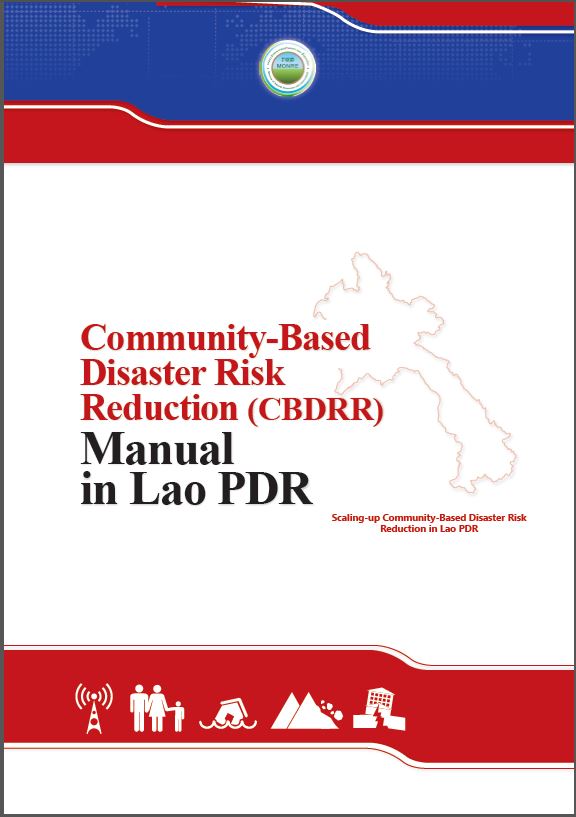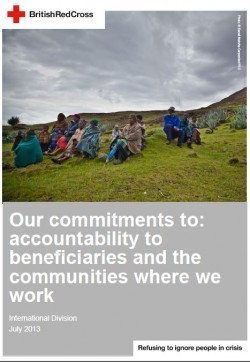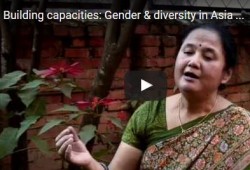One Billion Coalition (a powerpoint presentation)
This presentation was delivered by Indira Kulenovic (IFRC) at the Regional Community Safety and Resilience Forum of Southeast Asia National Societies in Indonesia in August 2015.
The presentation explains briefly what the One Billion Coalition is and what it means for the National Societies.
![]()
Community-Based Disaster Risk Reduction (CBDRR) Manual in Lao PDR
Purpose:
The CBDRR Manual is a practical ‘how-to’ guide on community-based disaster risk reduction for government and non-government agencies in Lao PDR. It is a commonly agreed document to be referred to by agencies working on CBDRR in Lao PDR. It provides guidance and support for systematic implementation of CBDRR programs by explaining each of the steps as well as tools used.
The manual will also support the Government of Lao PDR (GoL) to monitor CBDRR activities, oversee progress of activities implemented by different actors and locations, provide necessary support on CBDRR technical knowledge as well as provide a reference point for replication of initiatives for local government and implementing agencies.
The manual was developed through a series of consultations with key stakeholders working on CBDRR in the country both from government and non-government agencies. Therefore, the CBDRR manual is based on
common activities implemented by different stakeholders in Lao PDR incorporating country regulations, government perspective and concerns.
Overview:
The CBDRR manual consists of:
Part I is an introductory part which gives background information about CBDRR in Lao PDR (including the importance of CBDRR in Lao PDR, the stakeholders of CBDRR in the country, as well as an overview about
the challenges and opportunities when implementing CBDRR in Lao PDR).
Part II contains the instructions on how to conduct the eight step process agreed upon by government and non government agencies working on CBDRR in Lao PDR. The 8 steps involved are:
Step 1: Pilot site selection
Step 2: Baseline study
Step 3: Capacity building for CBDRR facilitators
Step 4: Capacity building for VDPCC
Step 5: Community disaster risk assessment
Step 6: Participatory disaster risk management planning
Step 7: Community managed-implementation
Step 8: Participatory monitoring and evaluation
Usage: Guideline for implementation and monitoring
Target audience: National Society staff and volunteers
![]()
Disaster Law South East Asia Snapshot
Purpose: Overview of the progress of the international disaster response law in the Southeast Asia region
Usage: Learning from experience
Audience: Technical staff, National Society leadership, Communication staff
For Snapshot of June 2015, click here June Snapshot, size 2 MB
For Snapshot of January 2015, click here January Snapshot, size 2 MB
![]()
Gender and Diversity in Resilience Toolkit Brief
Purpose:
IFRC South-east Asia Regional Delegation (SEARD) is working to increase the integration of gender equality into national and regional DRR policies and programmes in order to achieve reduced vulnerability to disasters of communities in Southeast Asia. One of the key ways SEARD is working to achieve this is by building the capacity of National Societies in the region to integrate gender and diversity into the work they do. One of the ways this will be achieved will be through the development of an online open-source toolkit.
Overview:
The toolkit comprises a comprehensive but selective set of resources on gender and diversity for DRR and resilience. This is available for IFRC and its member National Societies to ensure they have access to a single online platform containing all the resources they need to practically integrate gender and diversity within all aspects of their work.
Usage: Training
Audience: Technical staff, Communication staff, Gender and diversity practitioners, Volunteers
![]()
Our Commitments to: Accountability to Beneficiaries and the Communities where We Work
Purpose:
What is accountability to beneficiaries (AtB)? Why is it important? What types of work should apply these commitments? How should AtB commitments be applied when working with partners? This document details the British Red Cross’s eight AtB commitments.
Overview:
At the programme level, AtB commitments include:
- Communicating who the British Red Cross are and what they do – sharing and discussing timely information with beneficiaries and communities, and ensuring operations are transparent;
- Participating in programme decisions – enabling beneficiaries and their representatives to play an active role in programme design and the decision-making processes and activities that affect them;
- Using evidence as the basis for decisions (systematically collecting, using, and learning from evidence to inform programmes and demonstrate impact);
- Hearing and responding to complaints (setting up complaints and response mechanisms through which beneficiaries and communities can question programmes and actions, and get feedback about how these will be acted upon).
At the organisational level, AtB commitments include:
- Staff and volunteers’ competencies – ensuring staff and volunteers have the competencies needed to meet AtB commitments;
- Improving approaches for achieving AtB –assisting partners to review and improve approaches for strengthening AtB;
- Leadership and management for quality – putting in place policy and processes that places intended beneficiaries at the centre of decision-making, and ensuring these AtB commitments are modelled in organisational ways of working;
- Collaborating with partners to strengthen AtB – working with partners to raise awareness of, strengthen commitments to, and support the realisation of AtB.
Annex 1 (p.15) looks at the links between the eight AtB commitments and the Humanitarian Accountability Partnership (HAP) 2010 standard benchmarks.
Usage: Guidance for project implementation, policy guidance
Audiences: National society leadership, Technical staff
Reference: British Red Cross (July 2013). Our commitments to: accountability to beneficiaries and the communities where we work (pp. 1-15). Available from: http://www.hapinternational.org/pool/files/BRC%202013_Accountability%20to%20beneficiaries%20and%20communities.pdf[Accessed: 19 December 2015].
![]()
Audio Visual: Building Capacities – Gender & Diversity in Asia Pacific
Purpose
This video is one of five documentaries created to illustrate best practice in building community and Red Cross and Red Crescent capacity in a variety of cultural contexts in Mongolia, Australia, Nepal and Cambodia.
Overview
- The capacity-building process involves communities identifying their needs, volunteers offering their time, staff coordinating resources, and domestic and international partners providing support where necessary. It ultimately helps the vulnerable better manage their lives, reduce the risks they face and improve their long-term health, well-being and livelihoods.
- In Mongolia the Red Cross strives to ensure that the voices of groups such as the elderly, disabled and women-headed households, which will usually not be heard, are included in planning and branch activities.
- In Nepal, involvement with Red Cross programmes have improved the lives of Nepalese women, especially in terms of challenges faced by them in the community, which limit their participation in discussions about decisions affecting them.
- Many Cambodians have experienced social isolation, exclusion or discrimination in different forms as victims of the AIDS virus, war or sexual assault. The Red Cross empowers such people as volunteers to achieve new and appreciated roles in their communities.
- In Australia, the Red Cross has increased its attention to the needs of groups who have been marginalised socially, economically and culturally.
Usage: Training; Guidance for project implementation
Audiences: Volunteers, youth, technical staff
![]()
Ten steps to creating safe environment – from awareness building to integration into PMI services
Purpose: This case study highlights how PMI adopts and integrate violence prevention in its services
Overview: The case study is divided into three parts:
- Background of the Ten Steps to creating safe environments (Ten Steps).
- What ‘Ten Steps to creating safe environments’ are
- Integration of creating safe environment into PMI services
Usage: Learning from experience
Audience: Technical staff
![]()









